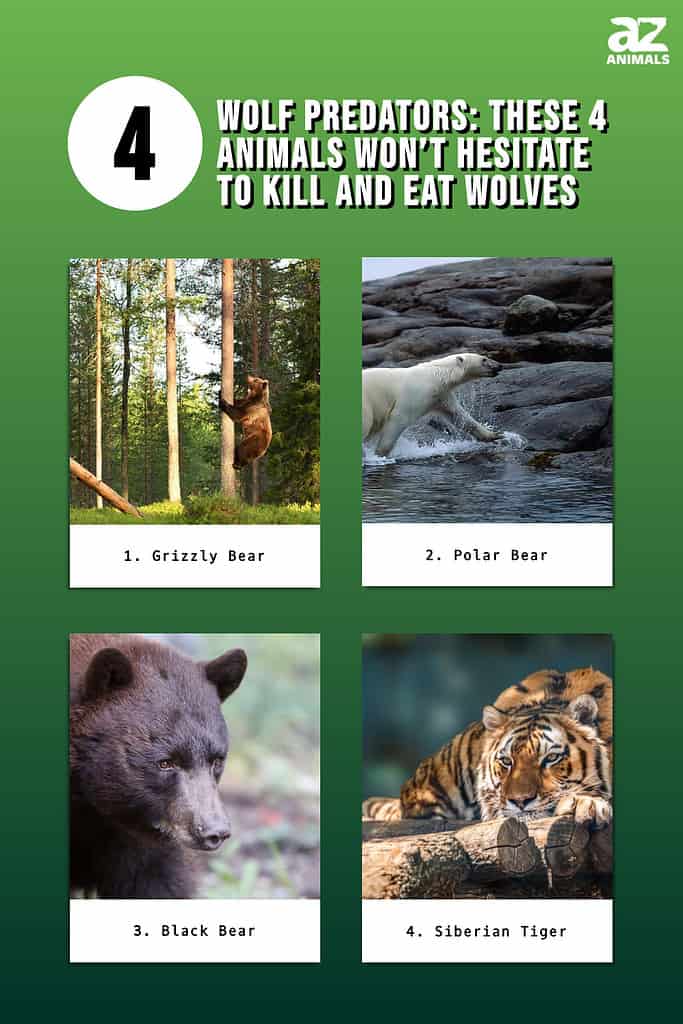
Gray wolves are skilled hunters and expert survivalists. They can survive in the desert, forest, and snowy tundra. These canines are twice as big as coyotes and can reach speeds of 37 mph! But despite all of their advantages, the forest can be a dangerous place for wolves.
When wolves attack moose or caribou, their prey can injure or kill them with a single kick. There are also rare cases where other apex predators will pose a threat. What animals do wolves have to watch out for? Follow along to discover what animals are bold enough to kill and eat wolves.
What Eats Wolves?
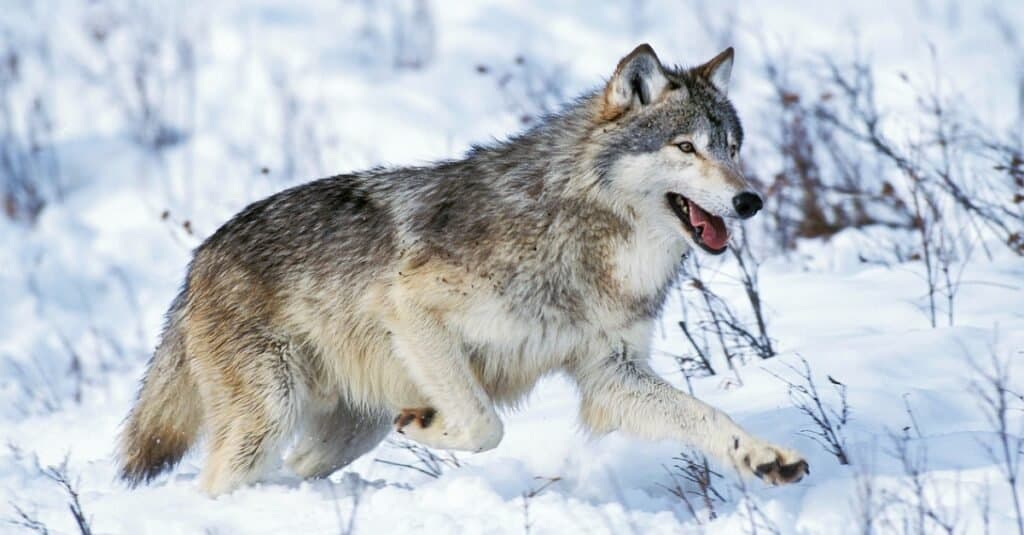
Wolves don’t generally have to worry about natural predators, but a few animals would hunt them, given the opportunity.
©iStock.com/slowmotiongli
Wolves don’t have to worry about natural predators. It’s rare for another species to hunt and kill a wolf for food. However, there are exceptions to this rule. When food sources are low, animals that generally pass on a wolf might start seeing these canines as the perfect meal.
Polar bears, grizzly bears, black bears, and the Siberian tiger will kill and eat wolves. But it’s a rare occurrence. Usually, the kills are competitive rather than predatory.
For example, a bear isn’t likely to go on a wolf-killing spree. But it’s a different story if one of these canines threatens their cubs! There are also instances of other bears or tigers trying to steal food from wolves, which can end badly for the canines if they’re not willing to share.
Other Threats
Gray wolves have other threats to their survival, like harsh weather, starvation, and hunting. These canines frequently wind up on the endangered species list because of overhunting. Thankfully, gray wolves aren’t on the list now. They currently hold a conservation status of the slightest concern.
Wolf Predator: Grizzly Bear
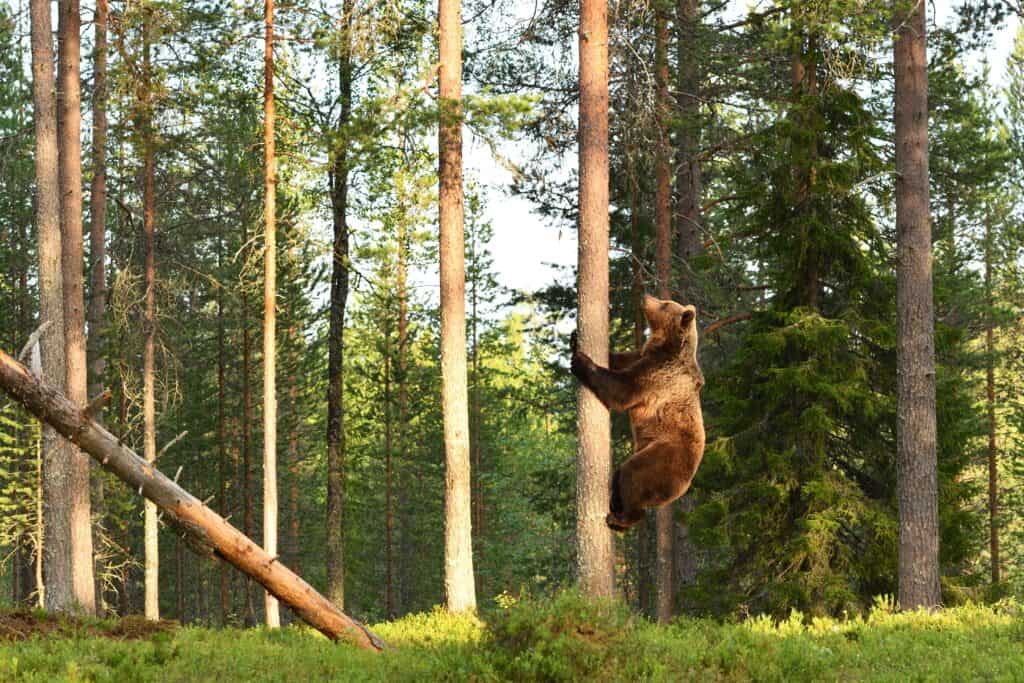
As apex predators, grizzly bears can take on almost anything that comes their way, if they have to.
©Erik Mandre/Shutterstock.com
Grizzly bears are fierce apex predators that can weigh over 600 pounds! Adult males usually weigh between 400 to 600 pounds, and adult females way between 250 to 350 pounds. Grizzly bears prefer living in the Arctic tundra, subalpine mountain forest, and Alpine tundra. You can find these beasts throughout Alaska, Montana, Wyoming, Washington, Idaho, Western Canada, and Southern Colorado.
As omnivores, grizzly bears eat a diet consisting of plants and other animals. When not dining on fruits and berries they love taking down large prey like elk, caribou, and moose. These bears are also kleptoparasites, which means they’ll take food from other animals, like wolves.
Grizzlies have a keen sense of smell that’s seven times better than hound dogs. They’re also highly intelligent, and fast. Once they find a meal, these bears don’t have any trouble catching them. Grizzlies can reach 35 mph on land and can also swim super fast.
Grizzly bears don’t normally eat wolves because it’s too much work. Wolves are faster than grizzly bears, and they usually travel in packs. However, there are rare instances when a hungry grizzly strikes out at a pack of wolves.
So what would make a grizzly try to take down a wolf? It has to be the perfect situation. For instance, sometimes wolves will try to steal food from grizzly bears. If the wolf fails, it can cost them their life. Once the wolf has been killed in battle, the grizzly isn’t going to pass up on fresh meat.
Wolf Predator: Polar Bear
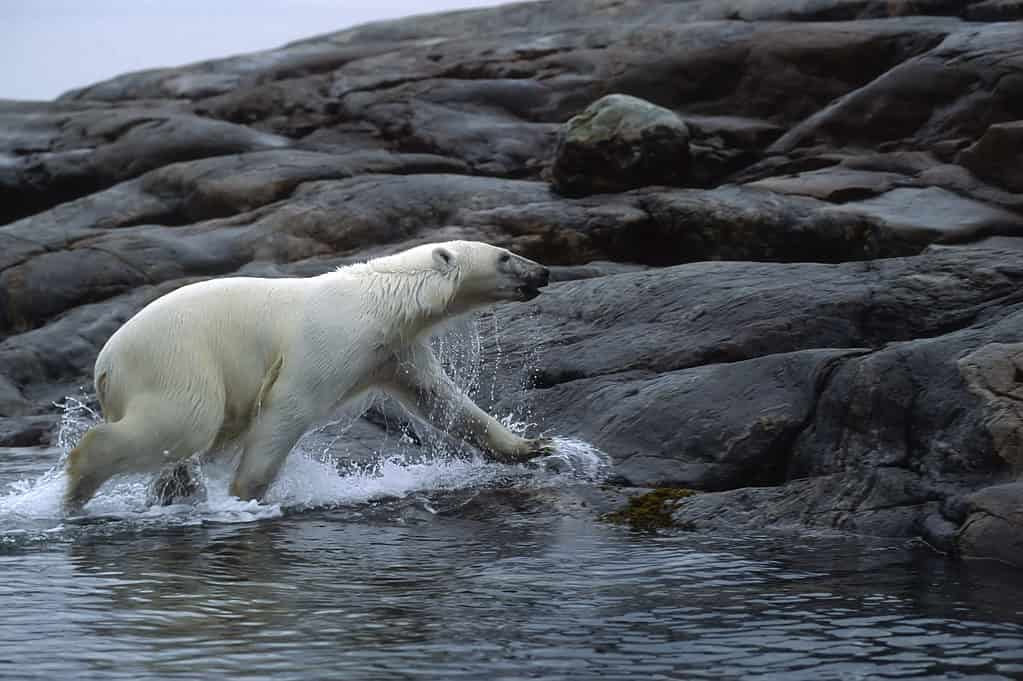
While a polar bear could hunt a wolf,
seals
are their first and primary prey.
©iStock.com/JohnPitcher
Polar bears are powerful predators who travel long distances across the ice to find food. These bears weigh around 1,500 pounds, but they can get much bigger! The heaviest polar bear ever documented weighed 2,209 pounds.
These massive bears live in the arctic. You can find polar bear populations in Canada, Alaska, Greenland, Norway, and Russia. It’s these areas that have their favorite type of prey.
Seals are the primary food source for polar bears. They love dining on ringed and bearded seals. They’ll hunt the seals by waiting at the water’s edge or breaking into pupping dens. Sometimes they even snatch seals right off the ice.
Polar bears use the ice to cover long distances while hunting for seals and other marine animals. On rare occasions, they’ll also dine on Arctic wolves.
Arctic wolves, also known as polar wolves, are a subspecies of the gray wolf. They live throughout North America and Greenland, where population numbers fluctuate with food availability.
Arctic wolves are much smaller than gray wolves. On average, they’re only 3 feet long and weigh less than 200 pounds. A fully grown arctic wolf will usually weigh around 175 pounds.
A polar bear is most likely to eat wolves when food is scarce. Sometimes polar bears have to go two to three months without food. If they were to come across an arctic wolf during one of these starvation stents, they wouldn’t think twice about launching an attack. Polar bears might also attack arctic wolves if the canines try attacking their cubs.
Unlike forest wolves, who can usually find food within a few miles, arctic wolves must search vast distances for a meal. They might attack out of desperation if they encounter a polar bear and cubs. However, the polar bear is so big it could win against the small pack of arctic wolves. After the polar bear took down the pack, they’d have a feast.
Wolf Predator: Black Bear
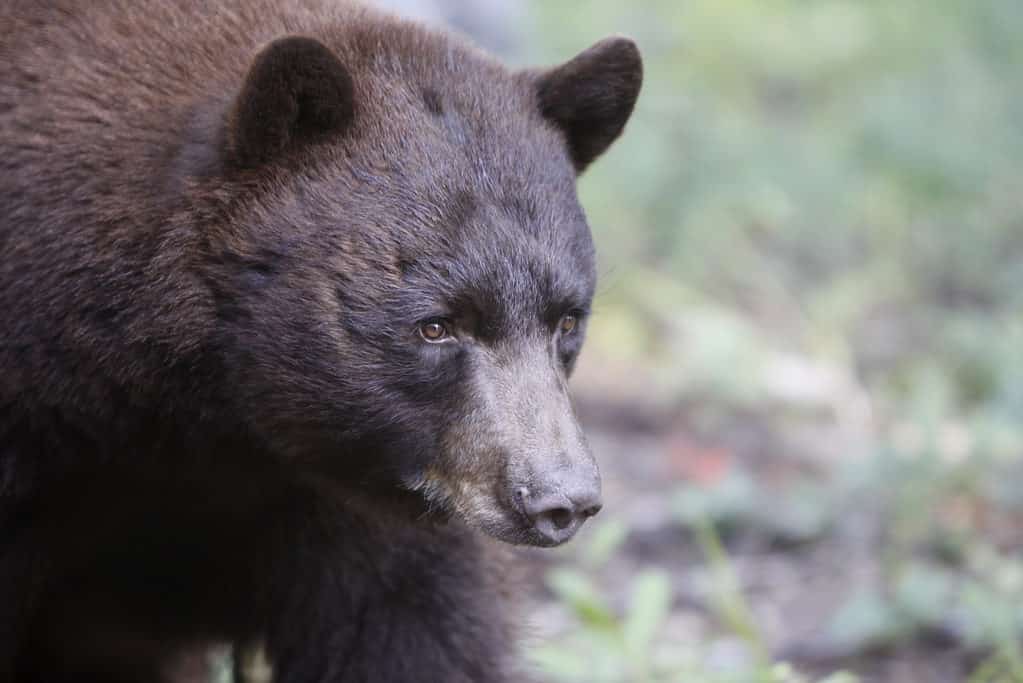
While not as large as polar or grizzly bears, black bears could still hunt and handle wolves.
©iStock.com/jjMiller11
Black bears are another predator that can eat wolves. Compared to polar bears and grizzlies, black bears are medium-sized. Females usually weigh between 100 to 200 pounds, and males typically weigh around 200 to 400 pounds. However, they can get much larger. The largest black bear in history holds the record at 1,100 pounds.
Black bears are found in Alaska, Canada, the Rocky Mountains, and the Southern United States. They live in the Appalachian mountains, the upper midwest, and even Mexico. These stocky forest bears are omnivores, which means wolf meat might be on the menu in special circumstances.
The black bear’s diet is 80% plants, 15% insects, and 5% animals. However, the diet fluctuates depending on the season and where they live. Fully mature black bears need 5,000 calories a day during the summer, and they need to quadruple that amount during the fall. Black bears take around 20,000 calories a day to prepare for winter.
Thankfully finding food is easy with their keen sense of smell and excellent vision. Black bears can see in color similar to humans, which helps them search for prey. They can also run over 30 miles per hour in short sprints, making it easy for them to catch up with the swift gray wolf.
However, similar to grizzly bears, black bears don’t usually attack wolves. There are instances where a black bear will kill and eat a wolf, but they’re specific situations. For example, if the wolf threatens the bear’s cubs, the black bear won’t think twice about going for the kill. They’re also known to attack wolves who try it steal food from them. Finally, if a lone wolf is sick or injured, black bears might see this as an opportunity and attack. If they know the wolf isn’t going to put up too much of a fight, they’ll gladly go in for the kill.
Wolf Predator: Siberian Tiger

Their diet typically consists of deer, birds,
pigs
, elk, and the like, but Siberian tigers will hunt wolves in certain circumstances. It is rare, though.
©iStock.com/Kathrine Andi
Siberian tigers are fierce and relentless predators. Males usually weigh an average of 660 pounds, and females average about 400 pounds. These wild cats live in Eastern Russia, and there’s even a small population of them in North Korea and across the border into China.
As expert survivalists, Siberian tigers are comfortable with harsh climates and high altitudes. They spend most of their time stalking prey in Eastern Russia’s birch forests. Their diet includes deer, birds, pigs, leopards, elk, bears, wild boars, and lynx. They’ll also dine on small rodents and fish when large prey is scarce. And in special circumstances, gray wolves will be on the menu.
Siberian tigers are ambush predators who prefer to attack their victims from behind. Their sharp teeth can be as big as 3 inches long and they have mighty jaw muscles. Their agile bodies and flexible spine make it easy to pounce on unsuspecting prey. They can also run 40 mph, making them faster than the speedy gray wolf.
It’s rare for tigers to eat wolves. But it is common knowledge in Eastern Russia that these two animals don’t get along. If an attack does happen, it’s usually competitive rather than predatory. That means the tiger usually attacks the wolf to defend its territory, not because it sees the wolf as the food source. However, once the wolf is killed, the tiger isn’t going to waste a good meal.
The photo featured at the top of this post is © David Rasmus/Shutterstock.com
Thank you for reading! Have some feedback for us? Contact the AZ Animals editorial team.






